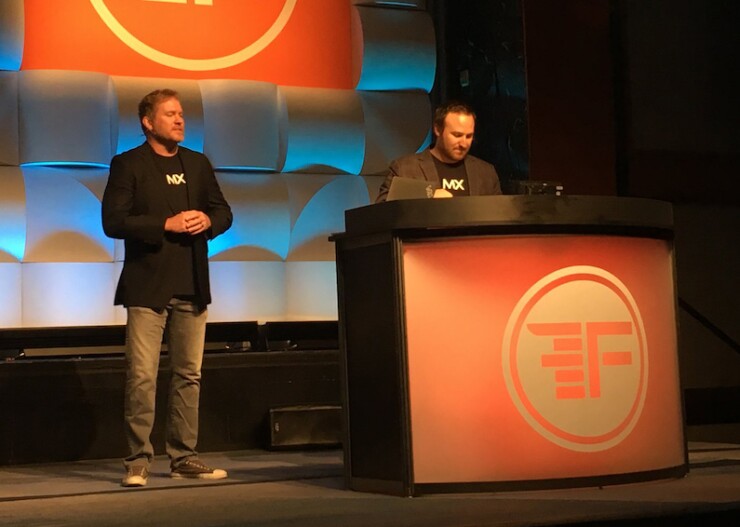The first Finovate show in 2007 teemed with 20-somethings in T-shirts and jeans who were eager to take on the establishment.
Many of the startups’ pitches began with some version of “banks are terrible at ... ” and ended with how the presenters were going to revolutionize finance.
This week at Finovate Fall, the attire and mood at the show, which gives financial technology companies seven minutes each to do a live demo of their wares, were entirely different.
The crowd looked older (not that there’s anything wrong with that) and more corporate, with men in suits and women in modest dresses or skirts, silk blouses and jackets. The few presenters who wore company T-shirts mostly covered them with black blazers.
In part, this reflects this fall’s fashions — conferencegoers were in sync with the New Yorkers on the sidewalks outside the event. But it also reflects how the fintech market has changed in 10 years.

“We've noticed in the first six or seven years of doing this, there were a lot of young people showing up, because they were on the fun edge of financial services, mostly in consumer finance,” said Nadeem Shaikh, CEO of Anthemis, a London-based venture capital firm that has invested in fintech companies since 2010.
“Now we see people who are in the middle of financial services, whether on the banking side or capital markets or insurance," he said. "For that to be disruptive, you have to have real substance, you have to really understand what you're talking about in that space, and then combine that with innovation and entrepreneurship. So we've seen fundamentally a shift in the age of the founders, with experienced folks coming in.”
The 70-plus presenters at Finovate were collaborators, not disruptors. They addressed the bankerly crowd with respect and pitched products created for them.
“It’s slowly shifting from ‘Hey we’re going to do something you’ve never seen before’ to ‘I’m going to go there because it’s a target-rich environment for the types of institutions I need to sell into,’ ” said Bradley Leimer, managing director and head of fintech strategy at Explorer Advisory and Capital.
Leimer also pointed out that banks have steadily paid more attention to the fintech market.
“Banks are now not only heavily attending events like this, they’re recognizing that this is not something that is going away,” he said. “And that the areas of friction the financial services industry has historically had as sources of revenue are something they need to remediate quickly before they start to truly lose market share. Whether you view this as a threat or a collaborative opportunity, that’s up to each institution.”
If all the hugging in the hallways is any indication, collaboration is the predominant mindset. A congenial fintech community has developed in this this space, and pretty much everybody knows everyone else.
There were a few clear themes at the show this year.
Several vendors showed artificial-intelligence-based chatbots or virtual assistants designed to help banks communicate with customers through their own apps, Siri, Amazon Alexa and Google Home.
SaleMove, Sensory, Finn.ai, Kony, Layer, eBankIT, Malauzai and Fiserv all showed their versions of this.
Security and authentication was another big topic, with many vendors capitalizing on the Equifax breach to say, “You need us to protect you.”
“How many of you are confident your personal credentials are not floating around the internet right now?” said Ted Ross, CEO of SpyCloud, which searches for stolen banking credentials in the dark web and either passes them on to a bank’s security department or reissues the credentials. Uniken, Averon, Privakey and Socure demonstrated authentication software; Jscrambler had a tool to prevent website tampering.
Mitek, ID Analytics and Digital Onboarding showed software for validating and onboarding new customers.
There were several online lending platforms, including Experian, eSignLive by Vasco, Quadient, Yukka Lab and ITSector. Mortgage Cadence, PromonTech and AI Foundry all offered means of streamlining the mortgage process. MX, Identitii, Cashoff, Kinetica, Endor, and GoodData pitched analytics software for better understanding data. And Moven showed Moven Enterprise, a way to see what app users are spending on and saving for.
The edgy fintech disruptors are still out there, but they are just not coming to Finovate. Some, like Square, are
The disruptors no longer need Finovate, accelerators or incubators because venture capital firms have stepped in to provide funding to early stage companies, Shaikh said.
“None of the disruptors go to Finovate anymore because it's become a banking trade show; it's more about today than tomorrow,” Shaikh said. “They don't need to go because there's a very sophisticated investor out there, there's a lot of demand for disruptive companies, so they can get access to capital without having to go beg and borrow.”
But Daniel Latimore, senior vice president of banking at Celent, does not see these challengers threatening banks’ livelihoods yet.
“Square and SoFi have grown tremendously, but still have relatively tiny market share,” he said. “They’re great illustrations of what’s possible, and they’ll push banks to get better, but they have a long way to go and a lot of things to do right before they’re meaningful threats to incumbents, who can’t, by the way, stand still.”
Editor at Large Penny Crosman welcomes feedback at





